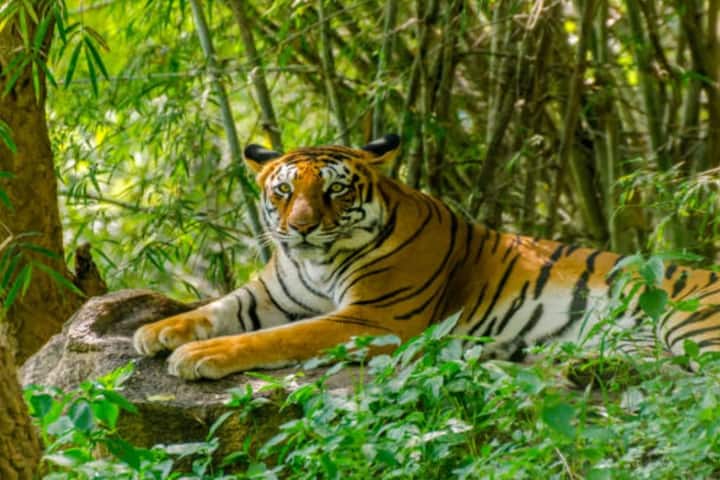

According to latest data the number of tigers is now 3,925 (Pic. Courtesy Twitter/@KirenRijiju)
The Union Ministry of Environment today on the occasion of the Global Tiger Day released two reports pertaining to this endangered species of big cat. One was a Comprehensive Tiger Report while the other was Management Effectiveness Evaluation of Tiger Reserves.
Started in 1973 Project Tiger has achieved commendable success, making significant strides in tiger conservation. In the beginning it covered nine tiger reserves spanning 18,278 square kilometres and today there are 53 reserves spread across 75,796 sq. km. effectively covering 2.3% of India’s total land area.
Incidentally, India has 75 per cent of the world’s wild tiger population.
The Wildlife Institute of India on the basis of analysis of the data gathered from camera-trapped and non-camera trapped areas with tiger presence, has pegged the upper limit of the population of the feline at 3,925. The average number of tigers is 3,682 which reflects a commendable annual growth rate of 6.1 per cent per annum.
Madhya Pradesh has recorded the largest tiger population of 785, followed by Karnataka (563), Uttarakhand (560), and Maharashtra (444).
The highest number of tigers have been found in Corbett (260). This reserve is followed by Bandipur (150), Nagarhole (141), Bandhavgarh (135), Dudhwa (135), Mudumalai(114), Kanha (105), Kaziranga (104), Sundarbans (100), Tadoba (97), Sathyamangalam (85), and Pench (77).
While the numbers have gone up in some areas, certain regions like Western Ghats showed localised declines. In some States, including Mizoram, Nagaland, Jharkhand, Goa, Chhattisgarh, and Arunachal Pradesh, disquieting trends with small tiger populations have been reported.
The MEE used by the Government has been adopted from the framework of the International Union for Conservation of Nature and Natural Resources World Commission on Protected Areas. It is a vital tool to assist and improve the management of tiger reserves and the landscapes associated with them.
The results of the fifth cycle of MEE of Tiger Reserves report in 2022 indicate an overall mean score of 78.01 per cent for 51 tiger Reserves. A total of 12 reserves have achieved Excellent category, followed by 21 in Very Good category, 13 in Good category and 5 in Fair category.
Both the reports were released by the Union Minister of State of Health and Family Welfare in the presence of Pushkar Singh Dhami, Chief Minister of Uttarakhand and Ajay Bhatt, Union Minister of State of Tourism at Corbett Tiger Reserve.
The e-commerce sector in India is expected to witness the highest salary increments in 2025,…
Taiwan detected seven Chinese Navy ships around its territory, Taiwan's Ministry of National Defence said…
The Dalai Lama was presented with a Gold Mercury Award on Monday in recognition of…
A spokesperson for the US government described a recent request from the Chinese government, urging…
India's National Disaster Response Force (NDRF) team has begun rescue operations under Operation Brahma at…
Prime Minister Narendra Modi on Monday extended greetings on the occasion of Eid-ul-Fitr. Taking to…